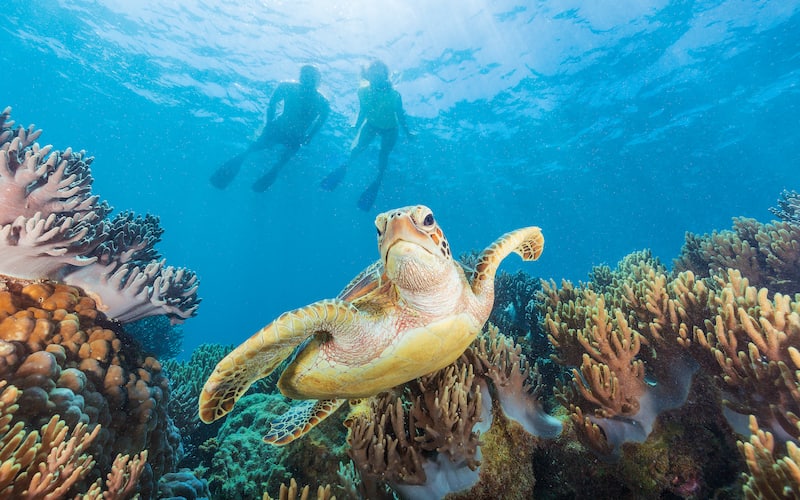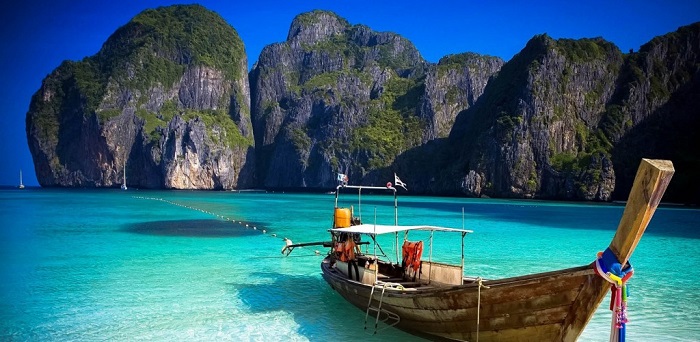
Discovering the Wonders of the Great Barrier Reef: An Underwater Adventure in Australia
When you think of natural wonders, the Great Barrier Reef stands out as one of the most iconic and awe-inspiring ecosystems on the planet. Located off the coast of Queensland, Australia, the reef is a UNESCO World Heritage Site and is the largest living structure on Earth, stretching over 2,300 kilometers. If you’re someone who loves nature, adventure, and the ocean, there’s no better place than the Great Barrier Reef for a once-in-a-lifetime experience.
In this article, we’re diving deep into everything you need to know about the Great Barrier Reef—from why it’s one of the best destinations for an underwater adventure, to the unforgettable experiences that await you. Whether you’re an avid diver, a beginner snorkeler, or someone who simply wants to learn about this natural wonder, get ready to discover what makes the Great Barrier Reef a must-visit destination.
Why Visit the Great Barrier Reef?
The Great Barrier Reef is much more than just a beautiful stretch of water. It’s an intricate, vibrant underwater world brimming with life, offering opportunities for adventure, relaxation, and environmental discovery. It’s one of the most biologically diverse places on Earth, hosting over 1,500 species of fish, 400 types of coral, and hundreds of other marine creatures, including sea turtles, sharks, whales, and even dolphins.
Here are some reasons why the Great Barrier Reef should be at the top of your travel bucket list:
• The Biodiversity: The reef is home to an incredibly diverse range of marine life. It’s one of the seven natural wonders of the world for a reason. Whether you’re snorkeling or diving, you’ll be surrounded by colorful corals, schools of fish, and fascinating creatures in every direction.
• Accessible for All Levels: The Great Barrier Reef offers a variety of experiences, from shallow waters perfect for beginner snorkelers to deeper dives for experienced divers. You can enjoy it from a boat, from the shore, or even from a glass-bottomed boat if you prefer to stay dry.
• UNESCO World Heritage Status: As one of the largest and most famous coral reef systems in the world, the Great Barrier Reef is protected and celebrated as a natural wonder. Visiting it not only gives you the chance to see incredible underwater life, but it also allows you to experience a unique, globally significant ecosystem.
• Amazing Scenery Above and Below the Water: Whether you’re flying over it on a scenic helicopter ride or kayaking through its turquoise waters, the Great Barrier Reef is just as stunning from above as it is below. The contrast between the clear blue water and the vibrant coral formations is something you’ll never forget.
Now that we’ve set the stage, let’s dive into some of the best ways to experience the Great Barrier Reef.
Best Ways to Explore the Great Barrier Reef
There are countless ways to explore the reef, each offering a different perspective of this stunning underwater world. Whether you want to dive deep into the ocean, snorkel along the shallow reefs, or take a leisurely boat ride, there’s an adventure for everyone. Let’s take a closer look at the different ways to explore the reef and what makes each one special.
1. Snorkeling: A Relaxed and Immersive Experience
For many, snorkeling is the first way they experience the Great Barrier Reef. It’s easy, accessible, and offers a direct connection to the underwater world. The beauty of snorkeling in the Great Barrier Reef is that you don’t need to be a professional diver to see the marine life up close. You can simply float on the surface and admire the vibrant corals and schools of fish below you.
Top snorkeling spots:
• Nudey Beach (Hinchinbrook Island): This secluded beach is famous for its crystal-clear waters and beautiful coral gardens. It’s perfect for those who want to snorkel in peace and beauty.
• Green Island: This small island off Cairns is a fantastic spot for snorkelers. The reefs around Green Island are home to colorful corals and abundant marine life, making it an ideal place for beginners.
• Whitsunday Islands: If you’re visiting the Whitsundays, the reefs here are shallow and full of life, offering excellent snorkeling opportunities.
Why snorkel the Great Barrier Reef?
• Snorkeling doesn’t require a lot of experience, and you can simply wear your gear and float in the shallow, warm waters.
• The visibility is typically excellent, often reaching over 30 meters, which means you’ll be able to see the underwater landscape clearly.
• You’ll encounter an array of marine life, from schools of parrotfish to the majestic manta rays and the elusive sea turtles.
2. Scuba Diving: A Deeper Dive into the Reef’s Wonders
If you’re ready to take your adventure to the next level, scuba diving is the way to go. Scuba diving allows you to go deeper into the reef and discover marine life that isn’t visible from the surface. Whether you’re exploring the Outer Reef or the Coral Sea, scuba diving in the Great Barrier Reef offers an unparalleled experience.
Top dive sites:
• The Ribbon Reefs: Located in the outer reaches of the Great Barrier Reef, the Ribbon Reefs are famous for their pristine corals and vibrant marine life. The clear waters and deep drop-offs make it one of the best dive sites in the world.
• Cod Hole: This iconic dive site is home to some of the largest fish in the world, including giant potato cods. It’s a great spot for both beginners and experienced divers.
• Osprey Reef: For experienced divers, Osprey Reef is an exhilarating spot where you can dive into deep waters and encounter large pelagic fish, including sharks, rays, and even whale sharks.
Why dive the Great Barrier Reef?
• Dive sites range from shallow areas to deeper spots, so divers of all skill levels can find something suitable.
• The underwater visibility is often spectacular, providing an unobstructed view of the colorful corals and diverse marine life.
• Diving allows you to interact with the reef in a more intimate way, exploring hidden corners of the reef that snorkeling just can’t reach.
3. Helicopter Rides: See the Reef from Above
Sometimes, the best way to appreciate the size and beauty of the Great Barrier Reef is to take to the skies. Helicopter rides offer breathtaking views of the reef, allowing you to see its vast expanse from a unique, bird’s-eye perspective. This is a must-do for anyone wanting to appreciate the sheer size and magnitude of the reef.
Why take a helicopter tour?
• The aerial views allow you to see the reef’s pattern of islands, coral formations, and vast stretches of blue water in all their glory.
• Helicopter tours are relatively short (around 30 minutes to an hour), so they can easily fit into your itinerary if you’re short on time.
• Some tours include stops over specific parts of the reef, including Heart Reef, a coral formation in the shape of a heart, which is one of the most photographed spots in the reef.
4. Glass-Bottom Boats: A Dry Yet Fascinating Exploration
For those who prefer to stay dry while still experiencing the reef’s wonders, a glass-bottom boat tour is a perfect option. These boats are equipped with large glass panels in the floor, giving you a clear view of the underwater world without getting wet.
Why choose a glass-bottom boat?
• It’s a great option for families with young children, those who can’t or don’t want to snorkel or dive, and people with limited mobility.
• The glass-bottom boat provides an easy way to see the reef’s vibrant corals, fish, and other marine creatures without having to get in the water.
• Many tours also have informative guides who explain the reef’s history, marine life, and conservation efforts, making it an educational experience as well.
The Best Time to Visit the Great Barrier Reef
While the Great Barrier Reef is a year-round destination, the best time to visit depends on what you’re hoping to experience.
• Summer (December to February): Summer is the warmest time of year, but it also comes with the highest chance of rain and humidity. This is also when the reef’s marine life is most active, with turtle nesting season happening around this time.
• Autumn (March to May): This is considered one of the best times to visit. The weather is still warm, and the rain has typically subsided. Water temperatures are comfortable, and marine life is abundant.
• Winter (June to August): Winter is the most popular time to visit, with cooler temperatures and excellent visibility for snorkeling and diving. The water is a bit cooler, but it’s still perfect for underwater adventures.
• Spring (September to November): Spring offers warm weather and great visibility. This is also the time when the reef is preparing for its annual coral spawning, a magical event that divers and snorkelers often try to witness.
The Importance of Conservation
As you enjoy the incredible sights of the Great Barrier Reef, it’s important to remember that this natural wonder is under threat. Climate change, pollution, and overfishing have all contributed to the reef’s decline in recent decades. The good news is that there are many ongoing conservation efforts aimed at preserving this unique ecosystem for future generations.
Several organizations are dedicated to protecting the reef and its biodiversity, and visitors are encouraged to follow sustainable practices, such as:
• Respecting marine life: Avoid touching the corals, as this can harm the delicate ecosystems.
• Minimizing pollution: Dispose of waste responsibly and reduce plastic use.
• Supporting eco-friendly tours: Choose eco-conscious tour operators who follow sustainable practices.
Conclusion: A Journey Like No Other
The Great Barrier Reef offers a once-in-a-lifetime opportunity to explore one of the world’s most spectacular natural wonders. Whether you’re swimming with tropical fish, marveling at vibrant corals, or simply relaxing on a boat, every moment spent here is a memory to treasure forever. The reef’s incredible biodiversity, its crystal-clear waters, and its unique landscapes make it a must-visit destination for any nature lover or adventure enthusiast.
As you plan your underwater adventure in Australia, keep in mind that the Great Barrier Reef is not just about diving or snorkeling; it’s about connecting with one of the Earth’s most treasured ecosystems, learning about marine conservation, and experiencing firsthand the beauty that nature has to offer.
So grab your snorkeling gear, hop on a boat, or take to the skies in a helicopter—the Great Barrier Reef is waiting for you!





